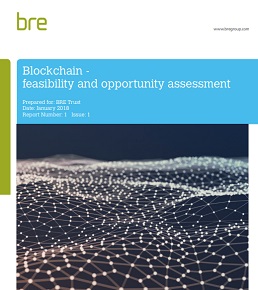Blockchain – feasibility and opportunity assessment
A new report from BRE Trust, published in February 2018, explores opportunities to address challenges in the built environment industry using blockchain technology.
Distributed Ledger Technology (of which blockchain is one application) is a digital record of the economic transactions or changes in the ownership of an asset. The information is shared and continually updated on a network of computers simultaneously, whilst secured through cryptography. This means that while allowing digital information to be distributed, but not copied, a blockchain is both transparent and incorruptible.
The new report, ‘Blockchain – feasibility and opportunity assessment’, draws insights from two workshops run by the BRE Trust in partnership with Constructing Excellence and industry professionals. The issues it covers include:
- The potential for better ‘track and trace’ of products throughout their life cycles, to give a clear picture of where they came from, who supplied them and who installed them.
- The evolution of distributed energy systems to support more localised energy creation and use.
- The use of blockchain technology to help tackle modern slavery and human trafficking by creating more transparency in construction supply chains.
- Connected districts and cities with the Internet of Things – blockchain technology offers a distributed system of registers, all of which are connected through a secure validation mechanism.
Dr Shamir Ghumra, Director of the Centre of Sustainable Products said:
“This report will help inform the current debate on Distributed Ledgers and Blockchains; there are many opportunities and synergies we can explore with this evolving technology for the betterment of the built environment itself but importantly we should see direct benefit and engagement with all parts of the value chain.”
The report presents how blockchain could be applied to a wide range of built environment sectors, but each potential application comes with questions and implications that warrant further investigation.
For example, in an industry that relies heavily on the regulation, certification and verification of products and services, the risk of human error when creating coding raises the question of whether a private or a public blockchain would be more appropriate.
While both act as distributed peer-to-peer networks, private blockchains have organisations or governing bodies retaining control and verifying all users of the system. Artificial intelligence and sensing technologies could also help reduce the human-error risk factor, and provide a means of automatically certifying and verifying application processes.
Also, large public blockchains currently require huge amounts of energy to extract – ‘or mine’ – the information needed to create the blocks – i.e. the records – that are linked to form the chains. With an increased focus on optimum efficiency and sustainability, the built environment industry will need to find new solutions to address this issue. The potential to disrupt and change the way parts of the built environment work and create value is about to take the jump forward, as Mark Farmer, co-Chair of Constructing Excellence said [we need to] “modernise or die”.
The report, ‘Blockchain – feasibility and opportunity assessment’, is available on the BRE Group website.
This article was originally published here on 22nd February 2018 by BRE.
[edit] Related articles on Designing Buildings Wiki
- BRE articles on Designing Buildings Wiki.
- Blockchain could transform the construction industry.
- Blockchain definitions.
- Blockchain technology in the construction industry.
- Blockchains will change construction.
- Construction innovation.
- Eliminating waste at scale – opportunities for blockchain.
- Is disruptive innovation possible in the construction industry?
- Non-fungible token NFT.
- Student projects released as non-fungible tokens.
- Unprecedented innovation and new technologies on the horizon.
Featured articles and news
Ebenezer Howard: inventor of the garden city. Book review.
Grenfell Tower fire – eight years on
A time to pause and reflect as Dubai tower block fire reported just before anniversary.
Airtightness Topic Guide BSRIA TG 27/2025
Explaining the basics of airtightness, what it is, why it's important, when it's required and how it's carried out.
Construction contract awards hit lowest point of 2025
Plummeting for second consecutive month, intensifying concerns for housing and infrastructure goals.
Understanding Mental Health in the Built Environment 2025
Examining the state of mental health in construction, shedding light on levels of stress, anxiety and depression.
The benefits of engaging with insulation manufacturers
When considering ground floor constructions.
Lighting Industry endorses Blueprint for Electrification
The Lighting Industry Association fully supports the ECA Blueprint as a timely, urgent call to action.
BSRIA Sentinel Clerk of Works Training Case Study
Strengthening expertise to enhance service delivery with integrated cutting-edge industry knowledge.
Impact report from the Supply Chain Sustainability School
Free sustainability skills, training and support delivered to thousands of UK companies to help cut carbon.
The Building Safety Forum at the Installershow 2025
With speakers confirmed for 24 June as part of Building Safety Week.
The UK’s largest air pollution campaign.
Future Homes Standard, now includes solar, but what else?
Will the new standard, due to in the Autumn, go far enough in terms of performance ?
BSRIA Briefing: Cleaner Air, Better tomorrow
A look back at issues relating to inside and outside air quality, discussed during the BSRIA briefing in 2023.
Restoring Abbotsford's hothouse
Bringing the writer Walter Scott's garden to life.
Reflections on the spending review with CIAT.
Retired firefighter cycles world to raise Grenfell funds
Leaving on 14 June 2025 Stephen will raise money for youth and schools through the Grenfell Foundation.
Key points for construction at a glance with industry reactions.
























